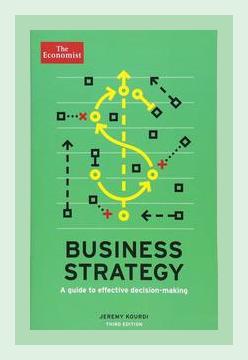Business StrategyStrategic Planning
Introduction
Jeremy Kourdi’s “Business Strategy: A Guide to Effective Decision-Making” is a comprehensive manual aimed at helping business leaders, managers, and entrepreneurs navigate the complexities of strategic planning. The book delves into the fundamentals of strategy development, decision-making processes, and practical tools to implement effective strategies. Notably, it is enriched with real-world examples and actionable insights that are immediately applicable in business scenarios.
Chapter 1: Understanding Strategy
Key Points:
- Definition of Strategy: Strategy is defined as a plan of action designed to achieve long-term or overall aims.
- Importance of Vision: A clear vision helps in aligning the organizational efforts towards common goals.
Concrete Examples:
- Example from the Book: The book outlines how Samsung redefined its vision to shift from a low-cost manufacturer to an innovator in technology, which led to its substantial growth in the smartphone market.
- Actionable Advice: Develop a clear and compelling vision statement that guides all strategic decisions within your organization.
Chapter 2: The External Environment
Key Points:
- PEST Analysis: Evaluating the Political, Economic, Social, and Technological factors that influence a business.
- Competitor Analysis: Assessing the strategies, strengths, and weaknesses of potential competitors.
Concrete Examples:
- Example from the Book: Kourdi cites the rise of renewable energy suppliers and how traditional energy companies like BP adapted their strategies to include greener, sustainable options.
- Actionable Advice: Conduct a thorough PEST analysis to understand external influences and anticipate changes in your industry. Regularly monitor competitors to stay ahead.
Chapter 3: Internal Capabilities
Key Points:
- Resource-Based View (RBV): Focuses on leveraging a firm’s internal resources and capabilities to gain competitive advantages.
- Core Competencies: Identifying and nurturing the unique strengths that differentiate a company from its competition.
Concrete Examples:
- Example from the Book: Kourdi discusses how IKEA capitalizes on its efficient supply chain and innovative design capabilities to offer affordable furniture without sacrificing quality.
- Actionable Advice: Identify your core competencies and invest in them to enhance competitive advantage. Conduct a resource audit to assess and refine these capabilities.
Chapter 4: Strategy Development
Key Points:
- Porter’s Generic Strategies: Cost Leadership, Differentiation, and Focus strategies.
- Growth Strategies: Ansoff’s Matrix including market penetration, market development, product development, and diversification.
Concrete Examples:
- Example from the Book: Apple’s differentiation strategy focuses on innovative product design and a robust ecosystem of software and services.
- Actionable Advice: Choose a strategic approach that aligns with your organization’s strengths. For instance, if focusing on differentiation, invest heavily in R&D and marketing to highlight unique product features.
Chapter 5: Decision-Making Processes
Key Points:
- Rational Decision-Making Model: A step-by-step approach to identify problems, generate alternatives, evaluate options, and choose the best solution.
- Cognitive Biases: Awareness of biases such as overconfidence and confirmation bias is crucial for making objective decisions.
Concrete Examples:
- Example from the Book: Kourdi refers to Toyota’s effective decision-making process, where issues are deeply analyzed using the “Five Whys” technique to identify root causes.
- Actionable Advice: Implement a structured decision-making process in your team. Regularly review past decisions to understand biases and improve future decision-making.
Chapter 6: Strategy Implementation
Key Points:
- Balanced Scorecard: A strategic planning and management system used to align business activities to the vision and strategy of the organization.
- Change Management: Effectively managing change through communication, training, and support for affected employees.
Concrete Examples:
- Example from the Book: Kourdi describes how Shell used the balanced scorecard to align its global operations with its strategic objectives, achieving greater clarity and efficiency.
- Actionable Advice: Implement the balanced scorecard framework to set clear objectives, measure performance, and ensure all organizational activities are aligned with strategic goals. Develop a comprehensive change management plan for introducing new strategies.
Chapter 7: Leadership and Culture
Key Points:
- Role of Leadership: Effective leaders inspire and motivate teams towards achieving strategic goals.
- Organizational Culture: A strong, positive culture supports strategic initiatives and enhances performance.
Concrete Examples:
- Example from the Book: The book highlights Google’s culture of innovation, where empowering employees to take risks has led to the development of groundbreaking products.
- Actionable Advice: Foster a leadership style that is transparent, supportive, and aligned with the company’s strategic vision. Continuously nurture a culture that promotes innovation and collaboration.
Chapter 8: Evaluation and Control
Key Points:
- Performance Monitoring: Regularly reviewing performance against strategic goals to identify areas of improvement.
- Feedback Mechanisms: Implementing systems to gather feedback and make necessary adjustments to strategies.
Concrete Examples:
- Example from the Book: Kourdi discusses how General Electric adopts a rigorous performance review system to maintain high standards and achieve strategic goals.
- Actionable Advice: Set up regular review meetings to evaluate progress and make data-driven decisions. Implement a robust feedback system to learn from both successes and failures.
Conclusion
Jeremy Kourdi’s “Business Strategy: A Guide to Effective Decision-Making” provides a thorough exploration of the nuances involved in strategic planning. By combining theoretical models with practical examples and actionable advice, the book serves as a valuable resource for anyone looking to develop and implement effective business strategies.
Summary of Actionable Steps:
- Develop a clear vision that aligns all organizational activities.
- Conduct PEST and competitor analyses to understand external influences.
- Identify and leverage core competencies to enhance competitive advantage.
- Choose the right generic or growth strategy that aligns with your strengths.
- Implement a structured decision-making process to minimize biases.
- Utilize tools like the balanced scorecard for tracking strategic goals.
- Foster a strong leadership and supportive culture within the organization.
- Regularly evaluate and refine strategies based on performance and feedback.
By adhering to these guidelines, organizations can navigate the complexities of the business environment and achieve sustained success.
